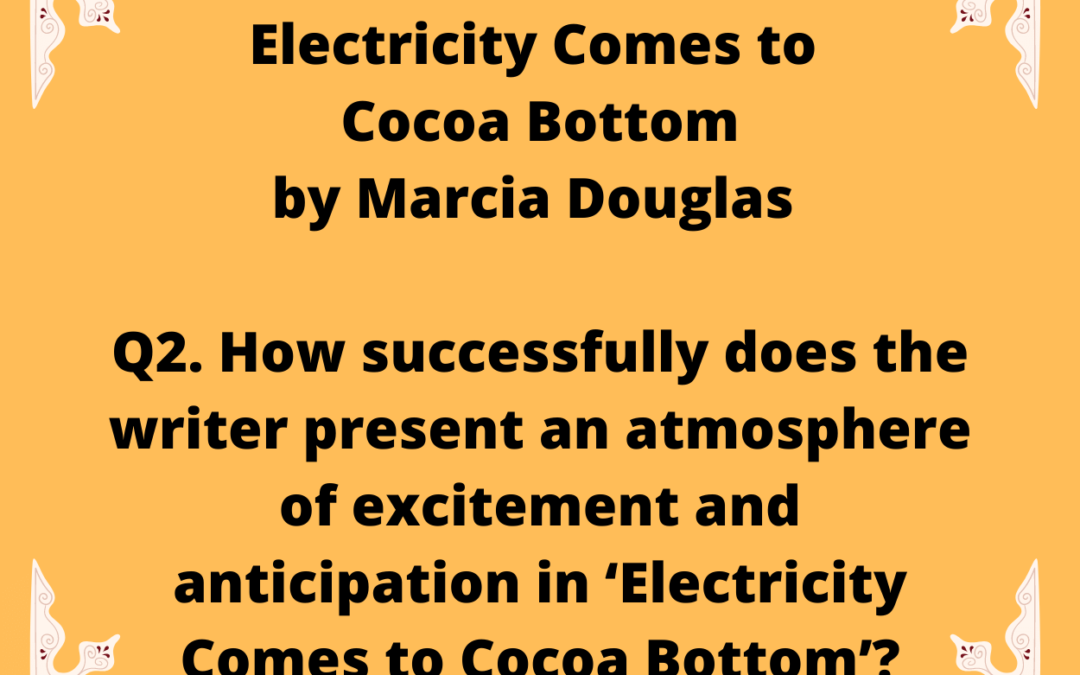Edexcel English IGCSE: Electricity Comes to Cocoa Bottom by Marcia Douglas
Q2. How successfully does the writer present an atmosphere of excitement and anticipation in ‘Electricity Comes to Cocoa Bottom’?
In your answer, you should write about:
- the feelings of the people and animals described;
- the way the writer uses the senses, especially sound and sight
- the writer’s use of words, phrases and techniques.
Refer closely to the poem in your answer. You may use brief quotations.
Edexcel English IGCSE Model Essay by an Expert
In this poem, both people and nature are portrayed as expectantly waiting for the revelation of Mr Samuel’s electric lights. The writer builds an atmosphere of suspense and tension, followed by an excited release. Throughout, the writer makes use of visual and aural imagery to capture the scene.
In the first stanza, both nature and humans are portrayed as being excited for the electric lights. As if united by their expectation of the event, the children and the animals are shown to be waiting. Their expectancy is shown with verbs which denote stillness and tension: the children were “waiting” and “watching”, and the fireflies and birds “waited” and were “congregating”. The repeated use of the present participle draws the reader into the moment, as if we too are involved in the atmosphere of anticipation. Personification suggests that even inanimate elements of nature are excited about the event: a breeze “held its breath”. The writer also makes use of an extended metaphor comparing the event to a theatre performance. There is a congregation like an audience, and the comparison of the evening to “curtains” is reminiscent of a theatre stage.
Whilst the first stanza is dedicated to anticipation, the second stanza creates an atmosphere of frenzied excitement. The first stanza ends with a slow pace and sense of finality, created by the repetition and full stops in “Closing. Closing.” This emphasises the excitement created by the sudden exclamation, “Light!”. The exclamation mark and the one-word line make this word seem like a joyful shout, which is repeated later in the stanza. Also contributing to the excitement is the religious imagery, which makes the event seem almost miraculous. The swelling breeze is reminiscent of the Pentecost: a religious event in the Bible. The grass, too, is personified as having “bowed heads”, which is suggestive of people praying.
The writer makes use of the reader’s senses to contribute to the excitement and anticipation. After the stillness and quiet of the anticipatory first stanza, the second stanza is a flurry of movement and sound, representing the release of tension when the lights come on. Verbs denoting activity create vivid visual images of sudden, excitable movement: “fluttering”, “swaying, swaying”, “rose up” and “stretching”. Onomatopoeia also contributes to this exciting scene, by appealing to the reader’s sense of hearing: “gasp”, “fluttering” and “tweet-a-whit”. This sensory overload is particularly emphatic following the quiet tension of the previous stanza, and thus highlights the excitement of the moment.
The poem ends by returning to a quiet, reflective mood, in which the writer seems disappointed by the brevity of the reaction and the lack of recognition of the momentousness of the event. Ironically, however, this poem serves as a successful rendition of the anticipation and excitement of the moment.




